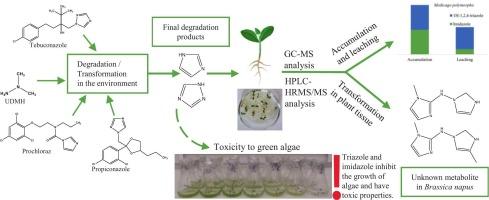Effects of imidazole and triazole on burr medic and oilseed rape seedlings: Phytotoxicity, transformation, and bioaccumulation
IF 8
1区 环境科学与生态学
Q1 ENVIRONMENTAL SCIENCES
引用次数: 0
Abstract
Pesticides are chemical substances of natural or synthetic origin used to control pests and insects. Environmental pollution occurs when pesticide contamination spreads away from the target plants. Pesticides and their transformation products can have adverse effects on both target and non-target plants and organisms. Azole antifungals, which are imidazole and 1H-1,2,4-triazole derivatives, are the most commonly used agents for treating invasive fungal infections. Imidazole and 1H-1,2,4-triazole are important degradation products of these substances. In this study, Brassica napus (oilseed rape) and Medicago polymorpha (burr medic) were used as test plants for imidazole and 1H-1,2,4-triazole accumulation and leaching experiments, and the green alga Scenedesmus quadricauda was used to determine their toxicity. Burr medic was found to absorb more 1H-1,2,4-triazole, whereas oilseed rape absorbed imidazole more rapidly with increasing concentrations. Imidazole leached from both species over time in the absence of an external pollutant source significantly faster than 1H-1,2,4-triazole. The algae experiment showed that 1H-1,2,4-triazole was more toxic than imidazole, and a mixture of imidazole and 1H-1,2,4-triazole at low concentrations was more toxic than the individual substances. Using GC–MS/MS, HPLC-MS/MS and machine learning methods, previously unknown imidazole metabolites in oilseed rape tissues were detected and their structures determined.

咪唑和三唑对毛刺和油菜幼苗的影响:植物毒性、转化和生物积累。
农药是天然或合成的化学物质,用于控制害虫和昆虫。当农药污染从目标植物扩散出去时,就会发生环境污染。农药及其转化产物可对目标和非目标植物和生物产生不利影响。唑类抗真菌药物是治疗侵袭性真菌感染最常用的药物,包括咪唑类和1h -1,2,4-三唑类衍生物。咪唑和1h -1,2,4-三唑是这些物质的重要降解产物。本研究以甘蓝型油菜(Brassica napus)和多形紫花苜蓿(Medicago polymorpha)为试验植物进行咪唑和1h -1,2,4-三唑积累和浸出试验,并以绿藻Scenedesmus quadricauda进行毒性测定。毛蕊草对1h -1,2,4-三唑的吸收效果较好,而油菜对咪唑的吸收随浓度的增加而加快。在没有外部污染源的情况下,随着时间的推移,咪唑从两个物种中浸出的速度明显快于1h -1,2,4-三唑。藻类实验表明,1h -1,2,4-三唑的毒性大于咪唑,并且咪唑与1h -1,2,4-三唑的低浓度混合物毒性大于单个物质。采用GC-MS/MS、HPLC-MS/MS和机器学习等方法,对油菜组织中先前未知的咪唑代谢物进行检测,并确定其结构。
本文章由计算机程序翻译,如有差异,请以英文原文为准。
求助全文
约1分钟内获得全文
求助全文
来源期刊

Science of the Total Environment
环境科学-环境科学
CiteScore
17.60
自引率
10.20%
发文量
8726
审稿时长
2.4 months
期刊介绍:
The Science of the Total Environment is an international journal dedicated to scientific research on the environment and its interaction with humanity. It covers a wide range of disciplines and seeks to publish innovative, hypothesis-driven, and impactful research that explores the entire environment, including the atmosphere, lithosphere, hydrosphere, biosphere, and anthroposphere.
The journal's updated Aims & Scope emphasizes the importance of interdisciplinary environmental research with broad impact. Priority is given to studies that advance fundamental understanding and explore the interconnectedness of multiple environmental spheres. Field studies are preferred, while laboratory experiments must demonstrate significant methodological advancements or mechanistic insights with direct relevance to the environment.
 求助内容:
求助内容: 应助结果提醒方式:
应助结果提醒方式:


